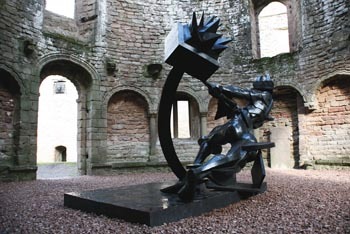Ever since he burst on the scene in the 1960s Michael Sandle RA has been the rogue elephant of British art. At Ludlow Castle, a perfect venue for work whose subject is war, both metaphorical and actual, his artistic power is irrefutable. This is a superb show. John Powis, who owns the castle, should be praised for his enlightened patronage and Judy Cox for curating with such panache. The event marks the inauguration of an annual sculpture exhibition of international standard.
The selection covers the past 30 years of Sandle’s output, 18 bronzes and one fibreglass, most of it done when he was professor of sculpture at two of Germany’s leading art schools.
At a time when hierarchical values have been constantly eroded, Sandle has stood for the pursuit of excellence, for quantifiable artistic and academic standards and public engagement with regard to content. As Colin Amery, the eminent architectural historian, said when opening the exhibition, Sandle ‘is tough because — unlike the temporarily fashionable contemporary artists — he is a moralist’.
Like one of his heroes, Wyndham Lewis, Sandle has not only opposed prevailing artistic attitudes but also spoken against them: ‘It is my misfortune to see art (read life) as a conflict, as an enervating struggle against mediocrity: in the first instance my own. We do, however, live in times of stupendous, quite heroic mediocrity. It is more than depressing to see the visual arts contaminated…with cynicism, or, what is even worse, through benign “democratic” agencies, being turned into a meaningless pap.’
Who but those blind to history could disagree?
Pap, cynicism and mediocrity are the last words one would associate with these challenging pieces positioned among the ruins and, in the case of the Tate’s ‘Twentieth Century Memorial 1971–78’, which has to be the outstanding post-war anti-war sculpture, in a local car showroom. This is art of angry resolve and melancholy reflection done with the obsession of Sandle’s own outstanding craftsmanship. Meticulous and sensual bronzes, which take as their subject war’s futility and propaganda without losing sight of its seductive power or denying self-expression: ‘War obviously goes into my psyche.
I’ve often used the notion of war as a metaphor for my own struggle and conflict.’
As a military child baptised on HMS Ark Royal and a witness to the blitzing of Plymouth, Sandle seems predestined to be the principal memorialist of his time, the heir to Gilbert, Sargeant Jagger and Lutyens. That only a handful of his works have reached public fulfilment is our loss as much as his.
He has even succeeded in updating the classical equestrian state, as he demonstrates again with his latest piece, ‘St George’s Horse’, 2007. This is an age of missiles and dirty bombs so his allegorical steed takes liberties with natural form. Its muscles are as angular as the lines of an armoured car, its tail as cone-like as a rocket’s warhead. In sunlight or floodlight the shadow against the stone lends speed to the flying tail and galloping hooves. All the pieces look at their Wagnerian best when twilight falls and bats flicker in the closing gloom.
The ruins provide separate and dramatic enclosures for each piece or thematic grouping. In one stands ‘Der Trommler’ (The Drummer), which in 1986 was the first winner of Japan’s most prestigious modern sculpture prize. It is a terrifying image, like Epstein’s 1915 ‘Rock Drill’ a reminder of war’s robotic inhumanity.
Another famous piece, ‘A Mighty Blow for Freedom’, in which a sledgehammer dispatches a TV set and all it implies, is perfectly placed in the circular remains of the chapel. These particular sculptures have been realised as public works. Many of the funereal monuments on display have not. One, ‘Mahnmal’ (Memorial), a cross with burning bomber’s wings, drew the comment: ‘So much for “The Angel of the North”.’ ‘Mahnmal’, an apology for Dresden, is certainly not corporate logos material.
Sandle’s draughtsmanship is exemplified by the beautiful drawing of ‘A Twentieth Century Memorial at Ludlow’. More sculptures, drawings and prints — including one of the anti-Iraq war drawing, which was the sensation of this year’s RA Summer Exhibition — are at Frost & Reed. Will these shows provoke the Tate to put ‘A Twentieth Century Memorial’ on permanent display, the powers that be to commission a Battle of Britain monument and others of his grand designs? Let us hope so.





Comments